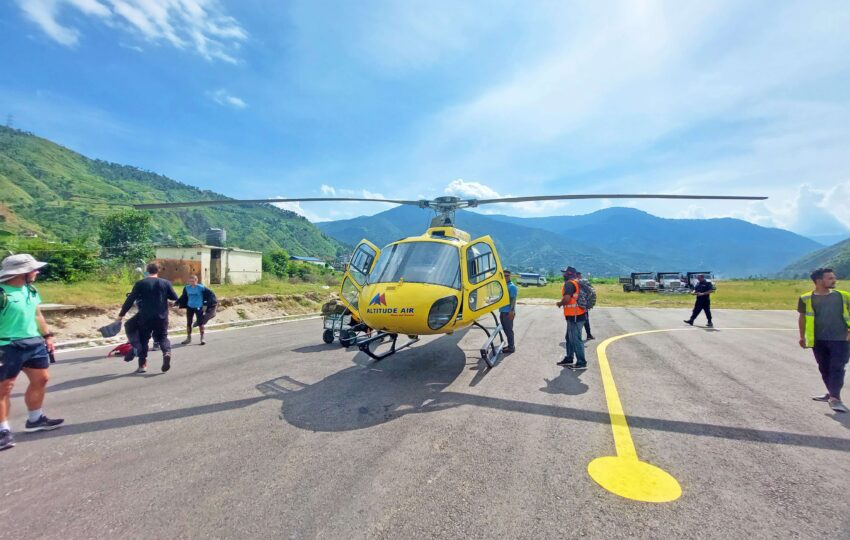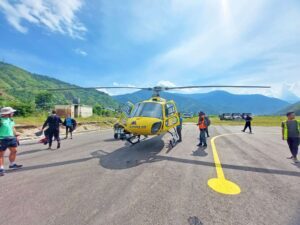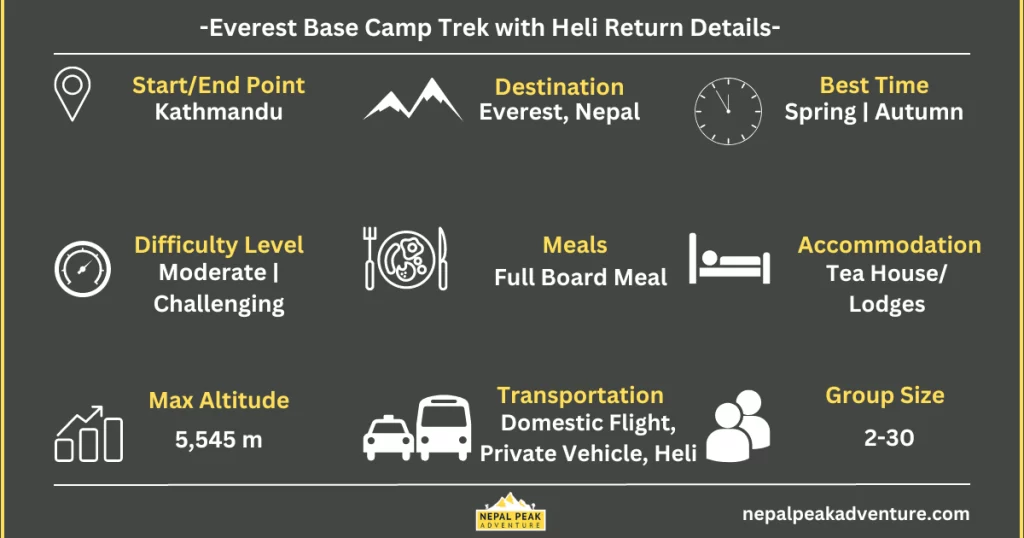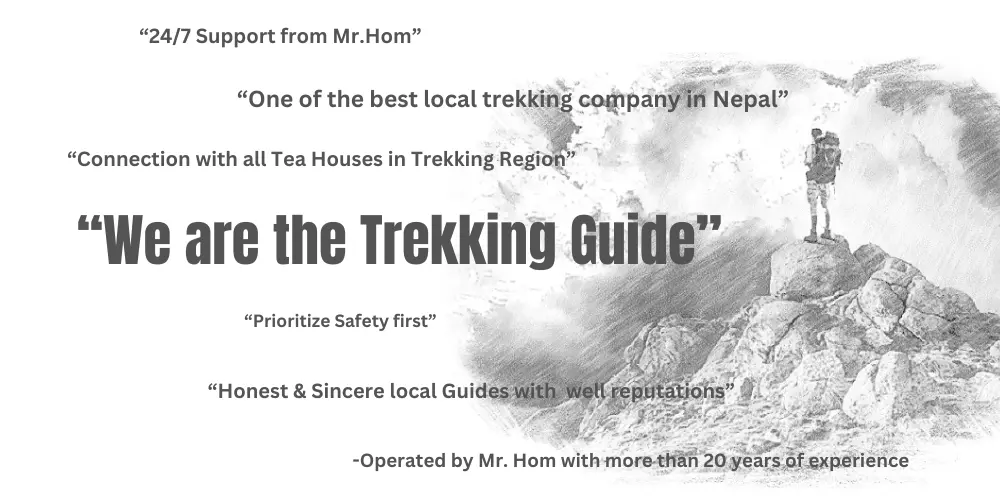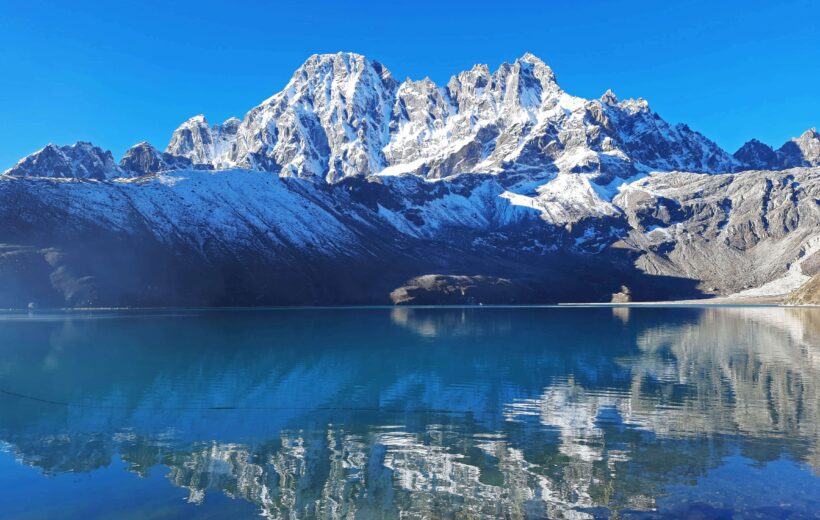Everest Base Camp Heli Trek is crafted for those who want to reach the Everest Base Camp while enjoying the nature, tradition, and culture of the Everest region regardless of their time constraints. Our motto is that one should not be deprived of his/her dream regardless of any limitations. We have designed this itinerary for those Everest dreamers who want to jump out of their busy schedules to reach the lap of the world’s tallest mountain.
Everest Base Camp Heli Trek will enrich your experiences through trekking and also provide you with an opportunity to get a bird’s-eye view of the world-famous Khumbu region. Besides, the highest peak on the Earth, Mount Everest (8848m), some other world-famous mountains such as Mount Lhotse (8516m), Mount Cho Oyu (8201m), and Mount Makalu (8481m) will be there offering you mesmerizing views.
The key distinction lies in the return leg from Gorakshep, where a helicopter ride shortens the trip significantly talking you to Lukla from Gorakshep. This not only saves three extra days of walking but also provides a breathtaking bird's eye view of the Himalayas. The aerial view adds a whole new dimension to the journey. The Everest Base Camp Heli trek caters to a diverse audience—from adventure seekers with short holidays to those desiring a touch of luxury in their trekking escapades.
For Whom Is The Everest Base Camp Heli Trek?
The Everest Base Camp Trek with Heli Return is designed to cater to a diverse spectrum of adventurers. Whether you find yourself constrained by a tight schedule, yearning for a touch of luxury, or simply seeking a more relaxed trekking experience, this journey has something special for you. For those with limited time, the Heli Return option ensures you can maximize your experience without compromising on the breathtaking views. If luxury is on your agenda, the helicopter return adds a touch of opulence, allowing you to traverse the entire journey in style. Additionally, if the idea of a shorter and more leisurely trek appeals to you, the Heli Return from Gorakshep to Lukla is the perfect solution. It's not just for those with time constraints; even experienced trekkers will find a new perspective in the aerial view of the Himalayas, adding a fresh dimension to their adventure.
Everest Heli Trek Outline Itinerary
- Day 01: Arrival day in Kathmandu (1400m)
- Day 02: Fly to Lukla and Trek to Phakding (2610m/8,563ft)
- Day 03: Trek to Namche Bazar (3440m/11,286ft)
- Day 04: Acclimatization day at Namche Bazar
- Day 05: Trek to Tengboche (3867m/12,687ft)
- Day 06: Trek to Dingboche (4410m/14,468ft)
- Day 07: Acclimatization day at Dingboche and day excursion around the place
- Day 08: Trek to Lobuche (4910m/16,109ft)
- Day 09: Trek to Everest Base Camp (5364m/17,598ft) via Gorekshep and trek back to Gorekshep (5164m/16,942ft)
- Day 10: Early morning hike to Kalapatthar (5545m/18,192ft) , Return Gorakshep and fly back to Lukla by helicopter
- Day 11: Fly back to Kathmandu via Plane
- Day 12: Departure from Kathmandu
Cost Inclusion and Exclusion
- Airport pick-up on arrival and transfer to your hotel
- Welcome Dinner at a Nepali cultural program
- Accommodation in a 3-star level hotel in Kathmandu for two nights including breakfast based on twin sharing
- Kathmandu - Lukla - Kathamndu Plane Flight Cost during the off-season
- Ramechhap - Lukla - Ramechhap Flight Cost During Spring & Autumn Season (Kathamndu - Ramechhap -Kathmandu private vehicle transportation cost)
- Domestic Transfers via private vehicle
- Teahouse/Mountain lodge accommodations during the trek | 3 nights with attached bathroom & Hot Shower (1-night in Phakding, 2 nights in Namche)
- Helicopter Ride from Gorekshep to Lukla Cost
- All three meals of the day (Breakfast, Lunch, and Dinner) during the trek
- 3 cups of tea/coffee per day during the trek
- Seasonal Fruits after dinner during the trek
- Professional Guide Cost & other expenses like salary, insurance, documents.
- Porter’s cost and expenses (one porter for every two persons)
- All trekking fees and permit fees as applicable
- All Government and Local taxes as applicable
- Down Jacket and sleeping bag for the trek (upon request) and should be returned after the trek
- One duffle bag (upon request) and a T-shirt as a souvenir
- Trekking map and trekking completion certificate
- Group medical kit box with necessary medicines
- The arrangement of Emergency helicopter evacuation service which will be covered by your travel Insurance plan
- Farewell Dinner
- Final departure transfer
Cost Exclusion
- Nepal visa
- Your expenses for mineral water, soft beverages, confectionaries, bar bills, and internet facility during the trek
- Other meals at Kathmandu besides breakfast, welcome dinner, and farewell dinner
- Extra baggage cost on a domestic flight.
- Personal trekking gears
- Your travel insurance covers helicopter evacuation
- Medical expenses
- Tipping to the porter, guide, and driver.
- Any other expenses or charges that are not included in the inclusion list.
Everest Base Camp Heli Trek Map
Everest Base Camp Heli Trek Route Overview
The journey begins with a scenic flight to Lukla, offering a breathtaking preview of the dramatic landscapes that await. Trekking through picturesque landscapes and traversing suspension bridges, each step brings you closer to the renowned Namche Bazar, a bustling hub nestled at 3440 meters.
The itinerary strategically includes acclimatization days at Namche Bazar and Dingboche, ensuring you adjust to the altitude while enjoying the warmth of traditional Sherpa hospitality. As you ascend, the vistas expand, revealing Everest, Lhotse, Nuptse, and the surrounding mountains, creating a panorama that etches itself into your memory.
The trail continues to several Sherpa settlements like Tengboche, Pangboche, and Dingboche, surrounded by stunning mountain vistas, leading you to the iconic Everest Base Camp at 5364 meters via Gorakshep. After achieving our main goal of reaching the Everest Base Camp a side trek to Kalapatthar at 5545 meters promises an unrivaled sunrise view of Everest and a 360-degree view of the surrounding mountains making the early morning ascent worthwhile.
You will then descend back down where the pinnacle of this journey lies in the unique Helicopter Return from Gorekshep to Lukla. This not only saves time but provides a thrilling aerial perspective of the Himalayas, complementing the ground-level adventure. The final leg of the trip includes a plane flight back to Kathmandu, concluding a remarkable trek filled with suspension bridges, traditional settlements, and amazing views of the Himalayas. This Everest Base Camp Trek with Heli Return seamlessly combines adventure, culture, and luxury, promising an experience that transcends ordinary trekking.
Meals
As part of our commitment to providing a seamless and nourishing trekking experience, the Everest Base Camp Trek with Heli Return includes full-board meals from day 2 to day 10. This encompasses a wholesome provision of breakfast, lunch, and dinner throughout the trek, crucial for restoring your energy levels amidst the challenging terrains.
Teahouses along the route offer a diverse menu, allowing you to choose from a wide range of food options. It's our priority to ensure that you have the sustenance needed to tackle each day of the trek. However, it's worth noting that we recommend avoiding meat items during the trek, as they may not be conducive to maintaining optimal health in high-altitude conditions.
While breakfast is included in the plan during your stay in Kathmandu, lunch and dinner in the city are at your discretion. This flexibility allows you to explore the local culinary scene and savor the flavors of Kathmandu on your own terms.
Drinking Water
For hydration on the trail, we strongly advise against consuming tap water directly, as it may pose health risks. Instead, we provide water purification tablets or sterilizers to filter the water from available sources. To promote environmental sustainability, we encourage you to bring a reusable water bottle and refrain from purchasing plastic bottled water during the trek.
Additionally, while trekking at high altitudes, moderation is key. We suggest avoiding excessive caffeine intake and advise on mindful drinking practices. These measures are in place to ensure not only the fulfillment of your dietary needs but also the overall well-being of trekkers throughout this extraordinary journey in the Himalayas.
Accommodation Facilities
As part of our comprehensive package, accommodations for the Everest Base Camp Trek with Heli Return are thoughtfully arranged to ensure your comfort and relaxation. The journey kicks off with a two-night stay in a star-category hotel in Thamel, Kathmandu. These accommodations, based on twin sharing, come with a Bed and Breakfast (BB) plan, allowing you to enjoy the vibrant atmosphere of Thamel before commencing your trek.
Once on the trail, teahouses become the quintessential accommodation option. These charming lodges offer cozy rooms equipped with a comfortable bedding setup, featuring beds with foam mattress covers and pillows. The walls are typically plastered or wood-paneled, providing a warm ambiance to unwind after a day of trekking. Each room comes with a window, offering scenic views of the surrounding landscapes.
Up until Namche, we ensure rooms with attached bathrooms, providing an added level of convenience. However, beyond Namche, the accommodations transition to more basic facilities. This adjustment is a reflection of the challenges posed by higher elevations, particularly in the Everest region. We appreciate your understanding of the limitations at these altitudes and assure you that despite the simplicity, our accommodations are designed to offer a comfortable and authentic experience amidst the breathtaking landscapes of the Himalayas.
Best time for the Everest Base Camp Heli Trek
The optimal time for the Everest Base Camp Trek with Heli Return is during the pre-monsoon (spring) and post-monsoon (autumn) seasons. These periods offer the most favorable weather conditions, ensuring a safer and more enjoyable trekking experience.
Spring (March to May): This season is widely considered the best time for the trek. The weather is relatively stable, with mild temperatures and clear skies. The rhododendron forests bloom, adding vibrant colors to the landscape, and the trails are lush and inviting. The chances of clear views of the Himalayas, including Everest, are at their peak during spring.
Autumn (September to November): Another excellent time for the Everest Base Camp trek is the autumn season. The monsoon rains have cleared the atmosphere, offering crisp and clear visibility. The temperatures are moderate, making it comfortable for trekking. The stunning landscapes, coupled with the favorable weather, attract a significant number of trekkers during this time.
While these two seasons are considered the best, it's crucial to note that weather conditions in the Himalayas can be unpredictable. Trekkers should be prepared for varying temperatures and the possibility of occasional rain or snow. It's advisable to check with local authorities and experienced guides for real-time weather updates before planning the trek.
Difficulty Level of Everest Base Camp Heli Trek
The Everest Base Camp Trek with Heli Return is considered moderately challenging, primarily due to its high-altitude nature and the demanding terrain it traverses. Trekkers should be prepared to walk for 5-7 hours per day, making it essential to maintain a reasonable level of fitness. While no previous trekking experience is required, being moderately fit is crucial for completing this trek.
The trails on this journey lead through challenging, remote, mountainous, and rough terrain. The route involves several ups and downs at high altitudes, requiring trekkers to navigate varied landscapes. The mountainous terrain includes rocky paths, steep ascents, and descents, demanding a certain level of physical endurance and mental resilience.
Another significant challenge of Everest Base Camp Heli Trek is the potential risk of altitude sickness. As you ascend to elevations like Everest Base Camp and Kalapatthar, the air becomes thinner, and there is a chance of experiencing altitude sickness. Adequate acclimatization, proper hydration, and following safety guidelines can help mitigate these risks.
Travel Insurance
For the Everest Base Camp Trek with Heli Return, travel insurance is not just a recommendation; it's a mandatory requirement. The unpredictable nature of high-altitude trekking makes it essential to have comprehensive coverage that includes medical and emergency evacuation, along with helicopter rescue services at altitudes of up to 6000 meters.
Trekkers are required to provide proof of their travel insurance by submitting a copy before commencing the journey. This precautionary measure is in place to prioritize your safety and well-being throughout the trek. In the event of any unforeseen circumstances, having adequate insurance ensures that you can receive prompt medical attention, emergency evacuation if needed, and helicopter rescue services in the challenging terrains of the Everest region.
Your safety is our top priority, and mandatory travel insurance is a crucial step towards providing a secure and enjoyable trekking experience.
Booking Process
The Everest Base Camp Heli Trek is a hassle-free endeavor with our straightforward booking process. To secure your spot, a modest deposit of 10-20% of the total trip cost is all that's required. Following this, we request essential documents, including a scanned copy of your passport, passport-size photos, travel insurance details, and flight information within a week of your deposit. Conveniently, you can deposit the required amount through a bank transfer, with detailed instructions available on our official website. The remaining balance can be settled in cash upon your arrival in Nepal.
We aim to simplify your booking experience, allowing you to focus on the excitement of the impending adventure. Should you need any additional information or assistance, our team stands ready to guide you through the process, ensuring a seamless and stress-free start to your Everest Base Camp Heli trek.
